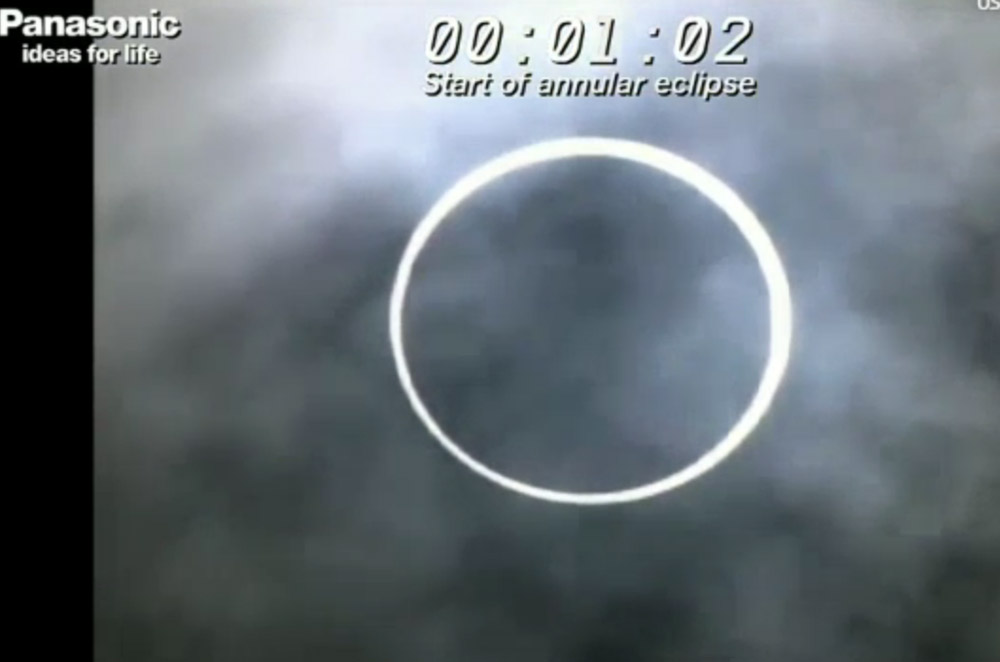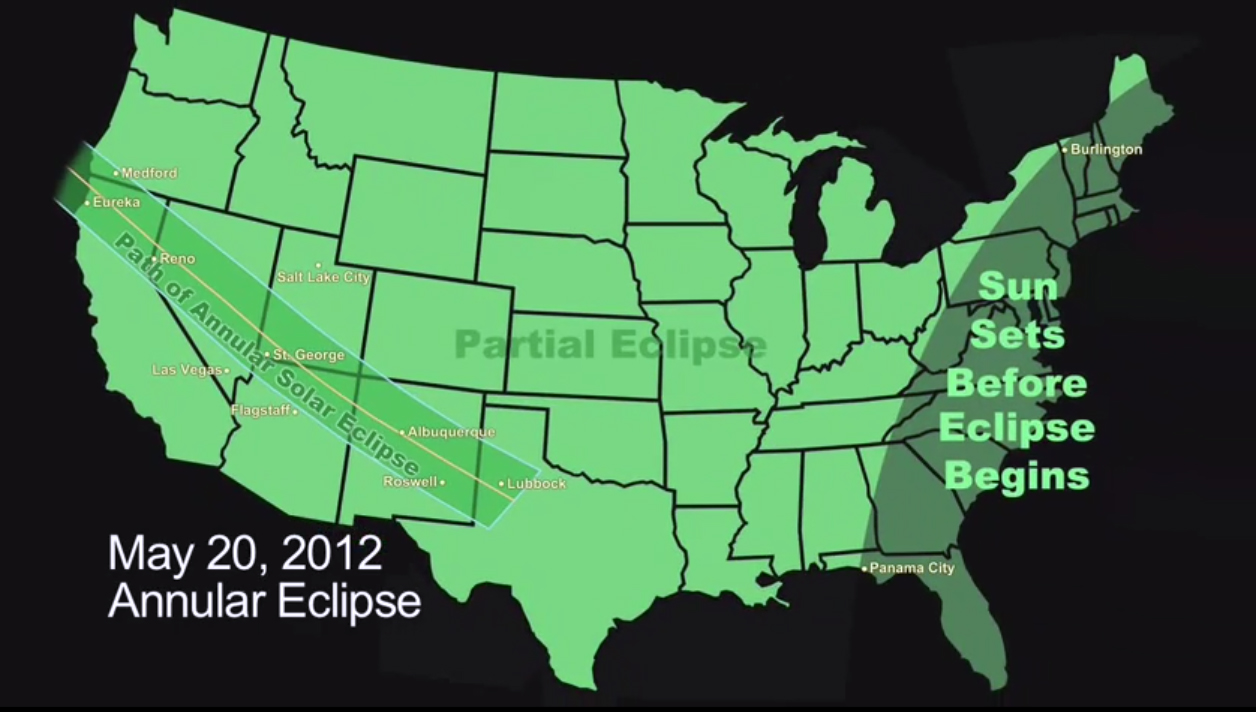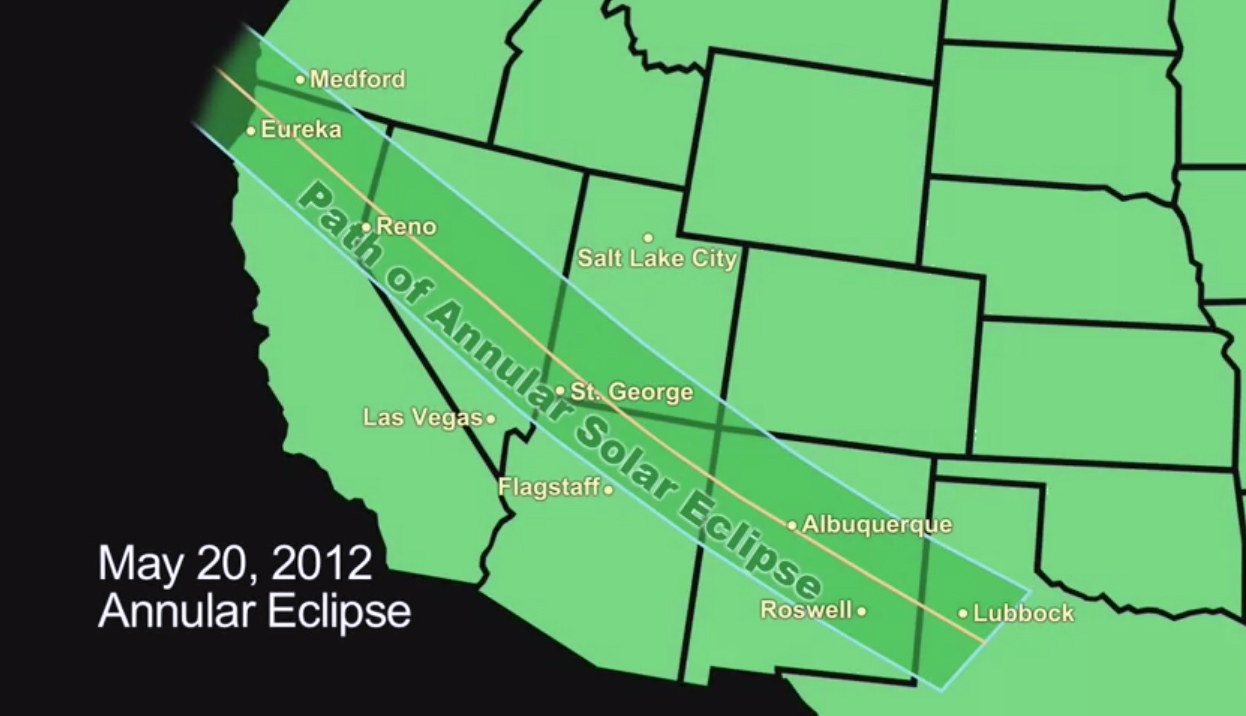Skywatchers Hot for 'Ring of Fire' Solar Eclipse

A rare solar eclipse is darkening skies from China to Texas today (May 20), and has crowds of eager skywatchers and photographers hoping to see the sun transform into a dazzling "ring of fire."
The so-called annular solar eclipse is not completely blocking the sun (like a total eclipse would). Instead, the moon will cover up to 94 percent of the sun at the eclipse's peak, leaving a bright ring of light – called an annulus, which means ring-like — around the moon's disc, NASA scientists said.
"The eclipse will be visible in a narrow path with the moon’s shadow traveling across the Northern Hemisphere," C. Alex Young, a solar physicist at NASA's Goddard Space Flight Center in Greenbelt, Md., explained today on his blog The Sun Today.
The shadow begins in East Asia, crosses the Pacific Ocean and ends in the western United States, Young added. While observers on a narrow path will see the full annular solar eclipse, skywatchers in regions further out will see a partial solar eclipse. [First Photos of May 20 Solar Eclipse]
In fact, the solar eclipse is already underway.
It peaked in southern China at about 6:36 p.m. EDT (2236 GMT) and was seen by cameras atop and around Japan's iconic Mt. Fuji, where a crew from Panasonic was webcasting live, a short while later.

Solar eclipse at Mt. Fuji
Get the Space.com Newsletter
Breaking space news, the latest updates on rocket launches, skywatching events and more!
Cameras at the Panasonic Eclipse Live from Fujiyama by Solar Power project's base camp and other sites captured the entire eclipse, which was Japan's first solar eclipse in 25 years. The cameras, all of which were solar powered, showed the moon slowly take a bite out of the moon, then shift from a partial eclipse into the full-blown annular event. About 277,000 people tuned into the webcast for the event, project officials said.
The climax of the eclipse was not visible from the summit of Mt. Fuji, where extreme winds, clouds and snow blocked the view.
"We gave it our best shot," said Jeff Jensen, an MC with the Panasonic's Mt. Fuji summit team for the webcast. "We were hoping to get a glimpse, but we just couldn't see it. It was almost a whiteout."
Next, the solar eclipse's shadow path will pass over the northern Pacific Ocean. It is expected to make landfall in southern Oregon and northern California at about 6:23 p.m. PDT (9:23 p.m. EDT/0123 GMT), then gradually cross central Nevada, southern Utah, and northern Arizona before ending in western Texas.

U.S. eclipse chasers ready
This is the first widely visible "ring of fire" solar eclipse in the United States in nearly 18 years, according to Young. While the full annular eclipse is only visible along a narrow track, most of the country —with the exception of the U.S. East Coast — will see a late afternoon or evening partial solar eclipse.
Some skywatchers and photographers have flocked to some U.S. National Parks (a NASA team is at the Grand Canyon), while others are hoping to find their own picturesque views.
"We couldn't sleep well last night, because you know, we were dreaming of the eclipse already," veteran space photographer Imelda Joson of Boston, Mass., told SPACE.com from outside Page, Ariz.
Joson and her husband Edwin Aguirre are an eclipse-chasing team and SPACE.com contributors. They plan to photograph the solar eclipse from winding Horseshoe Bend canyon outside Page. They've already scouted out their viewing site, which requires a 45-minute hike lugging all their equipment (two tripods, three cameras, four lenses and a solar telescope).
"The weather is fantastic," Joson said. "It's just beautiful."
World's largest solar eclipse party
In Boulder, Colo., astronomers and officials with the University of Colorado have reserved the university's Folsom Field football stadium to welcome 13,000 eager skywatchers hoping to catch a glimpse of the partial solar eclipse. The project, which organizers call the world's largest solar eclipse viewing party, is a partnership by the university 's Fiske Planetarium and Sommers-Baush Observatory.
The event began at 5 p.m. MDT (7 p.m. EDT/2300 GMT) and runs through sunset at 7:50 p.m. MDT (9:50 p.m. EDT/0150 GMT).
Doug Duncan, a University of Colorado astronomer with the planetarium, told SPACE.com the line at the gate was 500 people long at opening time. In the last 10 days, project officials had given out 50,000 solar eclipse glasses for the event.
Eclipse glasses in Boulder are in short supply, said Livescience senior writer Stephanie Pappas, who is covering the Folsom Field eclipse event for SPACE.com.
"They sold out at the planetarium about 20 minutes after it opened today," Pappas said, adding that a local hardware store was also carrying the solar eclipse observing gear. "There was an extremely big crowd at the Fiske Planetarium today at noon. There were hundreds of people there trying to get glasses. Clearly, there's a lot interest."
Eclipse glasses, special solar filters, welder's glass no. 14 and pinhole projectors or cameras are the only safe ways to observe the sun during a solar eclipse. NEVER look directly at the sun with the unaided eye or through a telescope without a solar filter. Severe eye damage can result.
See how to make your own pinhole projector in this SPACE.com video .Visit SPACE.com for complete coverage of today's annular solar eclipse today.
Editor's note: If you snap a great photo of Sunday's annular solar eclipse and would like it to be considered for use in a story or gallery, please send images and comments to SPACE.com managing editor Tariq Malik at tmalik@space.com.
Livescience senior writer Stephanie Pappas contributed to this report from Boulder, Colo. You can follow SPACE.com Managing Editor Tariq Malik on Twitter @tariqjmalik. Follow SPACE.com for the latest in space science and exploration news on Twitter @Spacedotcom and on Facebook.
Join our Space Forums to keep talking space on the latest missions, night sky and more! And if you have a news tip, correction or comment, let us know at: community@space.com.

Tariq is the Editor-in-Chief of Space.com and joined the team in 2001, first as an intern and staff writer, and later as an editor. He covers human spaceflight, exploration and space science, as well as skywatching and entertainment. He became Space.com's Managing Editor in 2009 and Editor-in-Chief in 2019. Before joining Space.com, Tariq was a staff reporter for The Los Angeles Times covering education and city beats in La Habra, Fullerton and Huntington Beach. In October 2022, Tariq received the Harry Kolcum Award for excellence in space reporting from the National Space Club Florida Committee. He is also an Eagle Scout (yes, he has the Space Exploration merit badge) and went to Space Camp four times as a kid and a fifth time as an adult. He has journalism degrees from the University of Southern California and New York University. You can find Tariq at Space.com and as the co-host to the This Week In Space podcast with space historian Rod Pyle on the TWiT network. To see his latest project, you can follow Tariq on Twitter @tariqjmalik.









